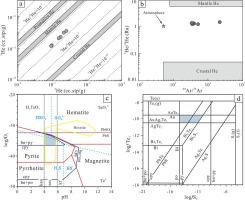当前位置:
X-MOL 学术
›
Ore Geol. Rev.
›
论文详情
Our official English website, www.x-mol.net, welcomes your feedback! (Note: you will need to create a separate account there.)
Mineral Paragenesis and Hydrothermal Evolution of the Dabaiyang Tellurium-Gold Deposit, Hebei Province, China: Constraints from Fluid Inclusions, H-O-He-Ar Isotopes, and Physicochemical Conditions
Ore Geology Reviews ( IF 3.3 ) Pub Date : 2021-03-01 , DOI: 10.1016/j.oregeorev.2020.103904 Dazhao Wang , Shimin Zhen , Jiajun Liu , Emmanuel John M. Carranza , Jiang Wang , Zhongjian Zha , Yongsheng Li , Haijun Bai
Ore Geology Reviews ( IF 3.3 ) Pub Date : 2021-03-01 , DOI: 10.1016/j.oregeorev.2020.103904 Dazhao Wang , Shimin Zhen , Jiajun Liu , Emmanuel John M. Carranza , Jiang Wang , Zhongjian Zha , Yongsheng Li , Haijun Bai

|
Abstract The Dabaiyang deposit is a typical Te-Au deposit hosted in Archean metamorphic rock in the Zhangjiakou district, northern margin of the North China Craton. It is located close to the famous Dongping Te-Au deposit; however, few researches have performed on the Archean metamorphic rock hosted Te-Au deposits, which precludes the studies on enrichment processes and mechanisms of Te-Au deposits in the Zhangjiakou district. In this contribution, four mineralization stages have been recognized in the Dabaiyang deposit: (1) K-feldspar−quartz veins; (2) quartz-pyrite veins; (3) polymetallic sulfide-quartz veins; and (4) calcite and quartz veins. Metallic minerals in this deposit include pyrite, chalcopyrite, galena, sphalerite, bornite, altaite, hessite, petzite, tetradymite, tellurobismuthite, native gold and electrum, and most of them were precipitated in stage III. Petrography, fluid inclusion microthermometry, and laser Raman spectroscopy revealed that the ore-forming fluid was a medium temperature H2O-NaCl hydrothermal system. Fluid temperatures evolved from 264–337℃ to 233–323℃ to 209–268℃ to 130–245℃, and salinities varied from 1.2–10.3 wt% to 1.2–8.8 wt% to 4.3–10.5 wt% to 3.8–8.3 wt% NaCl equivalent. Ore-forming fluids yield H and O isotope compositions of −2.4‰ to 4.9‰ and −101.2‰ to −75.5‰, respectively, and 3He/4He and 40Ar/36Ar ratios of 1.31–1.58 and 3489.0–21824.1, respectively. The hydrothermal fluids were derived initially from magmatic water (stage I), but more mixture of magmatic and meteoric water or heated meteoric water was added to the system (stages II and III), and significant water-rock exchange with the Sanggan metamorphic rock happened during evolution. Calculated physicochemical conditions of ore mineral formation shows that pH decreased, logfO2 and logfS2 did not change significantly from the early to the late stage; logfTe2 and logαAu+(aq)/αAg+(aq) values of stage III are -10.7 to -9.8 and -6.8, respectively. Ore-forming fluid did not suffer boiling during evolution, but mixing with low-temperature meteoric water and water-rock reaction were the dominant mechanisms that led to the precipitation of sulfides, tellurides and Au−Ag minerals in the deposit. The Dabaiyang Te-Au deposit is an epithermal gold deposit and its various hydrothermal fluid sources compared with intrusion hosted Te-Au deposits led to their differences in Te and Au contents, hydrothermal systems and mineral deposition mechanisms.
更新日期:2021-03-01



























 京公网安备 11010802027423号
京公网安备 11010802027423号